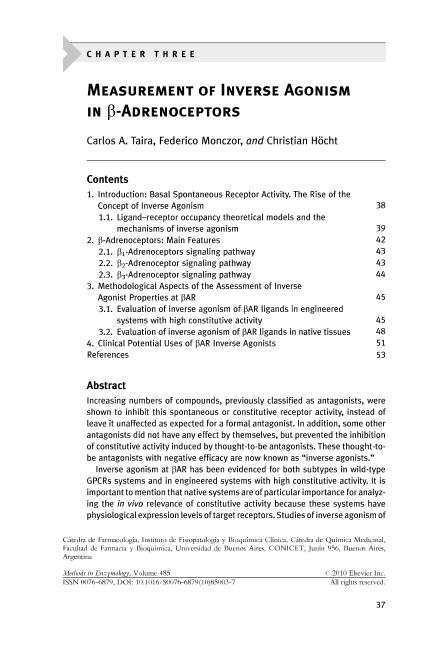Mostrar el registro sencillo del ítem
dc.contributor.author
Höcht, Christian
dc.contributor.author
Taira, Carlos Alberto

dc.contributor.author
Monczor, Federico

dc.date.available
2017-03-22T15:01:06Z
dc.date.issued
2010-12
dc.identifier.citation
Höcht, Christian; Taira, Carlos Alberto; Monczor, Federico; Measurement of inverse agonism in β-adrenoceptors; Elsevier Inc; Methods In Enzymology.; 485; 12-2010; 37-60
dc.identifier.issn
0076-6879
dc.identifier.uri
http://hdl.handle.net/11336/14170
dc.description.abstract
Increasing numbers of compounds, previously classified as antagonists, were shown to inhibit this spontaneous or constitutive receptor activity, instead of leave it unaffected as expected for a formal antagonist. In addition, some other antagonists did not have any effect by themselves, but prevented the inhibition of constitutive activity induced by thought-to-be antagonists. These thought-to-be antagonists with negative efficacy are now known as “inverse agonists.” Inverse agonism at βAR has been evidenced for both subtypes in wild-type GPCRs systems and in engineered systems with high constitutive activity. It is important to mention that native systems are of particular importance for analyzing the in vivo relevance of constitutive activity because these systems have physiological expression levels of target receptors. Studies of inverse agonism of β blockers in physiological setting have also evidenced that pathophysiological conditions can affect pharmacodynamic properties of these ligands. To date, hundreds of clinically well-known drugs have been tested and classified for this property. Prominent examples include the beta-blockers propranolol, alprenolol, pindolol, and timolol used for treating hypertension, angina pectoris, and arrhythmia that act on the β2ARs, metoprolol, and bisoprolol used for treating hypertension, coronary heart disease, and arrhythmias by acting on β1ARs. Inverse agonists seem to be useful in the treatment of chronic disease characterized by harmful effects resulting from β1AR and β2AR overactivation, such as heart failure and asthma, respectively.
dc.format
application/pdf
dc.language.iso
eng
dc.publisher
Elsevier Inc

dc.rights
info:eu-repo/semantics/openAccess
dc.rights.uri
https://creativecommons.org/licenses/by-nc-nd/2.5/ar/
dc.subject
Inverse Agonism
dc.subject
Β-Adrenoceptors
dc.subject
Constitutive Activity
dc.subject
Βar Inverse Agonists
dc.subject
Clinical Potential Uses
dc.subject.classification
Farmacología y Farmacia

dc.subject.classification
Medicina Básica

dc.subject.classification
CIENCIAS MÉDICAS Y DE LA SALUD

dc.title
Measurement of inverse agonism in β-adrenoceptors
dc.type
info:eu-repo/semantics/article
dc.type
info:ar-repo/semantics/artículo
dc.type
info:eu-repo/semantics/publishedVersion
dc.date.updated
2017-03-21T20:13:51Z
dc.journal.volume
485
dc.journal.pagination
37-60
dc.journal.pais
Estados Unidos

dc.description.fil
Fil: Höcht, Christian. Universidad de Buenos Aires. Facultad de Farmacia y Bioquímica. Departamento de Farmacología; Argentina. Consejo Nacional de Investigaciones Científicas y Técnicas; Argentina. Universidad de Buenos Aires. Facultad de Farmacia y Bioquímica. Departamento de Farmacología. Cátedra de Química Medicinal; Argentina
dc.description.fil
Fil: Taira, Carlos Alberto. Universidad de Buenos Aires. Facultad de Farmacia y Bioquímica. Departamento de Farmacología; Argentina. Consejo Nacional de Investigaciones Científicas y Técnicas; Argentina. Universidad de Buenos Aires. Facultad de Farmacia y Bioquímica. Departamento de Farmacología. Cátedra de Química Medicinal; Argentina
dc.description.fil
Fil: Monczor, Federico. Universidad de Buenos Aires. Facultad de Farmacia y Bioquímica. Departamento de Farmacología; Argentina. Consejo Nacional de Investigaciones Científicas y Técnicas; Argentina. Universidad de Buenos Aires. Facultad de Farmacia y Bioquímica. Departamento de Farmacología. Cátedra de Química Medicinal; Argentina
dc.journal.title
Methods In Enzymology.

dc.relation.alternativeid
info:eu-repo/semantics/altIdentifier/url/http://www.sciencedirect.com/science/article/pii/B9780123812964000038
dc.relation.alternativeid
info:eu-repo/semantics/altIdentifier/url/http://dx.doi.org/10.1016/B978-0-12-381296-4.00003-8
Archivos asociados
